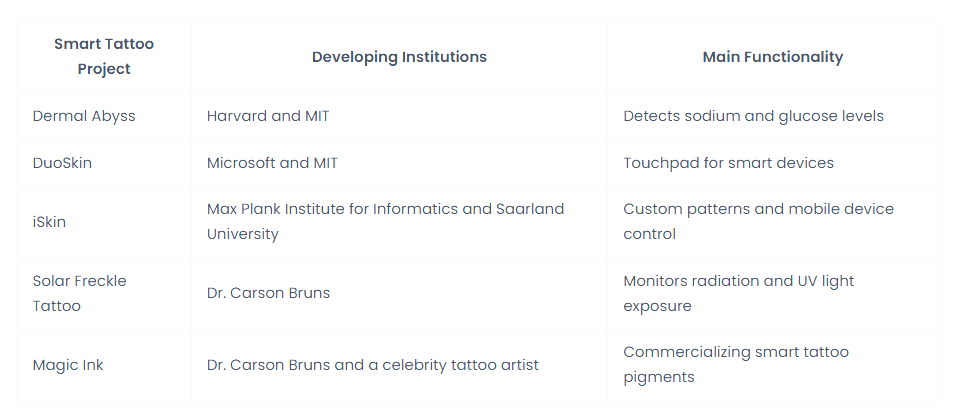
Riddle Me This: When Is a Tattoo Not a Tattoo?
When the
Tattoo is a Biological Computer Interface, Part 1

Introduction
Our Technological Overlords often seem hell-bent on interjecting the online experience into every aspect of our daily lives. By continually pushing new methods of intrusion into every aspect of the human experience, many people now feel lost when not connected to some network, some way — somehow. Not content to have every accessory now a connected device, the coming brave new world of connectivity intends to modify the human body itself into a quasi-organic computer interface. Bill Gates has been quoted as saying by the year 2030, "smartphones will be gone." And that electronic tattoos will replace the the bulky and archaic smartphone. Well, maybe not quite replace the smartphone — at least, not yet.
Part 1 of this series offers an introduction to the technology of
Bio-Connectivity. What it is. And how it works.
Part 2
examines what might be the wider implications of Bio-Connectivity
technology if and when it sees widespread adoption.
Part 1: The Technology of Bio-Connectivity
The science of connecting the human brain to electronic systems has been in development for over 100 years. Furthermore, an in-depth research paper, titled, "Revolutionizing brain‒computer interfaces: overcoming biocompatibility challenges in implantable neural interfaces," published in The Journal of Nanobiotechnology, July 10, 2025, posits that "Technology to record signals from the human brain has been available since the 1930s, starting with non-implantable electroencephalography and transcranial ECoG." ECoG is an acronym for what is known as Electrocorticography. As per Wikipedia, Electrocorticography "is a type of electrophysiological monitoring that uses electrodes placed directly on the exposed surface of the brain to record electrical activity from the cerebral cortex." Of course, the early implementations of brain-computer interfaces required dangerously invasive surgery, and the materials used to make the connections suffered from a high degree of rejection from the body. New technology has overcome many of the limitations of these earlier endeavors. Potentially bringing the brain-computer interface to anyone who may want such an interface.
While not yet quite ready for Prime-Time, this burgeoning new technology is known in the field as Bio-Connectivity. A current commercial application of Bio-Connectivity technology is the Dexcom glucose monitoring system. The Dexcom system, however, uses a polymer-based adhesive sensor attached to a rather bulky patch with a transmitter that sends its signal to a smartphone or smartwatch using Bluetooth Low Energy (BLE) as a connection. BLE is not as fast as traditional Bluetooth. Neither does BLE have the bandwidth required for sending and receiving large files compared to traditional Bluetooth. Also, traditional Bluetooth is an always on connection, whereas BLE has a sleep mode that suspends the device when its not in use. It is BLE lower power consumption and greatly extended battery life that provides the connectivity for the new technology of Bio-Connectivity to approach mass adoption.
A second technical innovation that lies at the root of this nascent technology is a material known as graphene. As Wikipedia explains it (with links):
In technical terms, graphene is a carbon
allotrope consisting of a single
layer of atoms arranged in a honeycomb planar nanostructure. The
name "graphene" is derived from "graphite"
and the suffix -ene,
indicating the presence of double bonds within the carbon structure.
Graphene is known for its exceptionally high tensile
strength, electrical
conductivity, transparency,
and being the thinnest two-dimensional material in the world. Despite
the nearly transparent nature of a single graphene sheet, graphite
(formed from stacked layers of graphene) appears black because it
absorbs all visible light wavelengths. On a microscopic scale, graphene
is the strongest material ever measured.
Graphene has been in use for medical applications for some time now. For instance, Graphene Electronic Tattoos (GET) have shown excellent results in cardiac monitoring in hospital settings. An IEEE Spectrum article, titled, "These Graphene Tattoos Are Actually Biosensors," authored by Dmitry Kireev, and dated February 3, 2025, discusses in depth how this new GET technology is currently applied in hospital settings to monitor heart rates and blood pressure. The material is especially well suited for the purpose because: "It's exceptionally conductive, transparent, lightweight, strong, and flexible. When used within an electronic tattoo, it’s imperceptible: The user can’t even feel its presence on the skin." Graphene technology is currently in use to track and monitor various types of biometric data, such as heart rate, hydration, glucose levels. That medical data can then be sent to a traditional device like a smartphone or smartwatch.
What might bring this promising technology into the mainstream is the emergence of the electronic tattoo. A succinct definition of what an electronic tattoo is made by author, Andreas Rekdal. Writing in website, Built-in, "What Is an Electronic Tattoo?, April 27, 2023, Rekdal defines an electronic tattoo thusly:
Electronic tattoos are soft, sensor-equipped wearable devices that attach to a person’s skin and are typically used to gather data. These devices are often made from conductive materials, like graphene, carbon or conductive polymers, which allow them to measure biopotentials, or electric signals emanating from the wearer’s body. (For example: muscle impulses, heart rate and brain activity.) They can be equipped with other sensors as well, including accelerometers, which track motion, temperature sensors, or even sensors that measure the chemical composition of the wearer’s sweat.
The concept of the electronic tattoo has arisen from GET technology. In a hospital setting, GET applications are practical because the material is easily connected to existing electronic monitoring and recording systems. Looking forward, in the next 5 to 10 years, the technicians and clinicians implementing GET technology "hope to integrate the e-tattoos with smartwatches." Research in the field is rapidly expanding. The chart below from, innovation.world, "Modern Technological Tattoos: When Wearable Technologies Enhance Body Art," lists some of entities active in the field, and their areas of interest.

source:
https://innovation.world/wearable-technological-tattoos/
Pushing this technology farther is conductive ink. Voltera is a Canadian firm that manufacturers conductive ink. Writing on its website, Voltera, "What Are Conductive Inks?," April 30, 2021, author Matt Ewertowski describes this new technology thusly: "A conductive ink is a material which is printed, processed, and conducts electricity." Ewertowski adds that the purpose of conductive ink "is to provide a path for electrons to get from A to B." Essentially doing what printed circuit boards do today.
Current technology requires a more traditional device, like a smartphone, smartwatch, or cloud server, to receive the data from a GET, whether the GET be a patch or conductive ink. To truly replace our current devices, a GET would need to connect to some type of neural link, more accurately known as a Brain-Computer Interface similar to what was discussed above. A 2024 report, titled, "Brain-Computer Interfaces, Applications, Challenges, and Policy Options," [pdf will open] that was published by the US General Accounting Office (GAO). The publication offers an authoritative guide to the current state of the art of Brain-Computer Interfaces (BCI).
As the GAO reports states, currently for a BCI to send and receive data, either an implant surgically placed inside the brain, or a wearable receiver, is required. One example of the consumer application of a BCI system that is in use today cited by the GAO is a game controller. Nevertheless, the technology continues to evolve and improve.
To move beyond the current send the data to a smartphone or other device scenario, neural implants must come to more resemble actual brain cells. An article titled, "The present and future of neural interfaces," which appeared in Frontiers in Neurorobotics, dated October 10, 2022, the article's authors defined the future of neural implants placed in vitro or inside the body.
In fact, the new generation BCIs and neuroelectronic platforms ultimately should resemble both the physical and electronic architectures and features of neuronal cells (Lubrano et al., 2020). While neuronal tissue engineering has greatly advanced in reconstituting biological neuronal networks from the single cell to scaffold-based tissue architectures, these platforms can be optimized in vitro and potentially be implanted in vivo to form functional connections over time.
Several constants in the world of technology are: rapid technological advances; greater adoption of new technology by a growing population of users; increasing production and distribution of new products; resulting in the lowering of retail prices for those new products. Thus, the Bio-Connected Tattoo might well be coming soon to you; at you; maybe even for you.
I've got you under my skin.
I've got you deep in the heart
of me.
So deep in my heart
that you're really a part of me.
I've got you under my skin.
— I've Got You Under My Skin , Frank Sinatra
Song
Writer: Cole Porter
Gerald Reiff